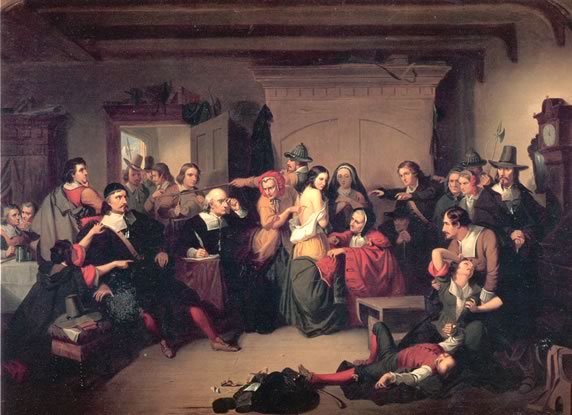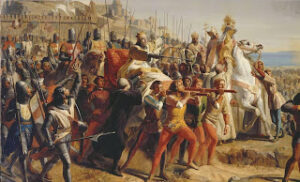Why would adults in Salem, Massachusetts in the 1690s take the accusations of nine year old girls seriously? During the seventeenth century, New England had grown diverse. The people living in the communities were of different backgrounds. But in the 1690’s there was an apparent outbreak of witchcraft. The most famous of these outbreaks was the event in Salem, Massachusetts in 1692 that stirred up the Salem community and soon spread to other communities.
The widespread hysteria over witches was all over the town after an accusation of witchcraft was made in January 1692. A group of young adolescent girls met in the home of Samuel Parris, a Puritan pastor in Salem. The pastor had a nine year old daughter, Betty. Betty and her cousin Abigail were fascinated by the voodoo tales and tricks told to them by the family slave. The family slave, Tituba, was the one whom the little girls had sought after for entertainment.1 It was not long after their time spent with Tituba, when the girls began to behave strangely; seeing visions, babbling at times, and lapsing into trances. The Puritans thought that these behaviors were of witchcraft, as the work of the devil. People in Salem began believing the girls, and charged Tituba and two other village women for practicing witchcraft on them. Two men, John Hathorne and Johnathan Corwin of Massachusetts, were called to do a legal examination of the women. The Puritans followed the Old Testament law. This was how they assessed the examinations. Scripture had a statement that said witches were not able to live. The two men knew exactly what they had to do. The examination was done on these women of Salem by looking for a certain mark on the body: a wart or tit. This specific mark was said to be the place where the devil and his demons would take blood out of the witch.2 Many of the women accused were of lower status in the community.

Research shows most of the accused witches were middle-aged women, widowed, with few or no children. Also, if the woman had been involved with domestic conflicts, they were accused. The women were accused of crimes and appeared to be dangerous by their neighbors. Women in Salem who inherited or possessed land were also accused of witchcraft.3 The accusations towards these women were out of the ordinary and seemingly wrong. One must first think about the view of women during this time. They were undermined and portrayed as having no power or knowledge of such things; they were subservient to the men in the community. Not only were low class women accused of witchcraft, but as time passed, superior women were accused as well.4
On October 29th, the Salem Witch Trials were called to an end. Governor Phips dismissed the Court and that marked the end to the witch hunt craze. Many were disappointed about the ending of the trials, but many were glad to return to work.5 The community in Salem blamed Pastor Parris for letting the innocent die. The people of the Salem church also voted to void his salary. In the following years, those family members of the deceased were restored their good names. The families were awarded a compensation for all the financial loses they went through during such tragic times. Increase Mather, a pastor of the Boston Puritan Church, wanted the people to do away with the court because he believed they put innocent people to death.
The Witch trials took on an important role in American History. The trials became a tragic and memorable moment in history. Generational, racial, and sexual hostility, opposition to law, social stresses, and food poisoning were all causes as to why the people had anxieties that found release in the witch hunt craze. The witch hunts became searches for scapegoats; the community leaders were looking for anyway possible to ease the community’s anxieties.6
- Kenneth P. Minkema, “In the Devil’s Snare: The Salem Witchcraft Crisis of 1692,” The Christian Century, no. 8 (2003): 37. ↵
- Salem Press Encyclopedia, January 2015, s.v. “Salem Witchcraft Trials,” by Warren M. Billings and Kimberly Manning. ↵
- Alan Brinkley, American History, 15th ed., vol. 1: to 1865 (2 Penn Plaza, New York, NY 10121: McGraw Hill Education, 2015), 86-87. ↵
- Salem Press Encyclopedia, January 2015 s.v. “Salem Witchcraft Trials,” by Warren M. Billings, Kimberly Manning. ↵
- Salem Press Encyclopedia, January 2015 s.v. “Salem Witchcraft Trials,” by Warren M. Billings, Kimberly Manning. ↵
- Salem Press Encyclopedia, January 2015 s.v. “Salem Witchcraft Trials,” by Warren M. Billings and Kimberly Manning. ↵



178 comments
Andrew Petri
This part of American history is, in my opinion, very interesting and dark. I read the crucible in high school, and I was so fascinated about the story. The Salem Witch Trials was basically a scandal where the only way to survive was putting the blame on someone else. In a way, there are still some cases like this today, where a corrupted justice system gets tainted by a rumor or lie. This was a very interesting article that dug deeper into a topic that everyone knows about.
Dalton Moy
I remember learning about the Salem Witch Trials in High School. However, I do not remember learning about what happened directly after these events. I was glad to read this article and hear that the families of those accused where able to have their name restored. I had honestly thought, prior to reading this, that the families just were perpetually tossed aside. I know that is pretty pessimistic, but I am glad to know now that at least some amends were made.
Eric Ortega Rodriguez
This is a very interesting article. In high school, I read countless books tied to the Salem Witch Trials. So reading this article really helped me understand more of what they were. Reading this article made me think how sad that innocent lives were lost because in essence, within the Salem Witch Trials, any woman could be accused of practicing witchcraft. Overall, very fascinating and original topic selection. Good work.
Averie Mendez
The Salem Witch Trials have always been very intriguing for me. So many innocent people were put to death on absolutely no evidence at all – just mean rumors. I think the entire village of Salem was just drawn to complete hysterics after the first so called “witch” and everything after that was just a rolling snowball of false accusations that resulted in so many unjust deaths.
Ryan Estes
Sometimes in American history I think: what were we thinking? This article is one example. I remember reading the Crucible in high school- I don’t remember much about the play but I think we watched the movie as well. It was pretty intense from what I remember. The Salem Witch Trials definitely were a dark period of time in America’s history, and I’m sure it didn’t help the evolution of tolerance (or lack thereof) towards women.
Makenzie Santana
The Salem Witch trials were so often talked about but without many details. I only ever heard the basics about it, a community paranoia that causes so many innocent lives to die under unreasonable accusations of witchcraft. I think back to that kind of time period and try to understand why they had such fears and could so easily feel threatened by anything that just seemed a little off. They hardly had any real knowledge of things like that, but it’s still so tragic that starting off with one person would cause a ripple affect of innocent lives.
Diego Terrazas
The Salem witch trials was essentially a game of pointing fingers. It is evident that they women being accused were women who had status and power compared to your traditional stay-at-home wife. It is sad they viewed voodoo as a devil-worshiping religion, since it really is not. Nevertheless, the Christian religion exploited this religion by deeming it satanic, and thus causing this mass chaos.
Hali Garcia
I have always loved learning about the Salem Witch Trials. When I was in junior high sometimes we would have to read books based on historical events and I would always choose the Witch Trials. What struck me when reading this article as well as the other books was that there was always one name that was brought up, Tituba. I also never really paid attention to who was being accused, but this article made me think and I have realized that it was mostly the lower class. Overall, this was a very captivating article.
Angel Torres
The Salem Witch Trials has always been an interesting topic to study in United States History. The actions and loss of life that resulted from the Salem Witch Trials is tragic. Many innocent people were put to death on mere accusations. The actions of Governor Phips were for the betterment of the community. The article did a great job on providing general information about the Salem Witch Trial, I hoped to have seen more detail on certain instances or accounts with in the Salem Witch Trials.
Gabriela Ochoa
The trials that took place were interesting no matter where they were but the ones in Salem have always been the ones to catch the most attention in the manner that they happened. I found it interesting that they also targeted women who had land of their own as I was in the belief that they only chose to believe that the lower classed women were targeted.